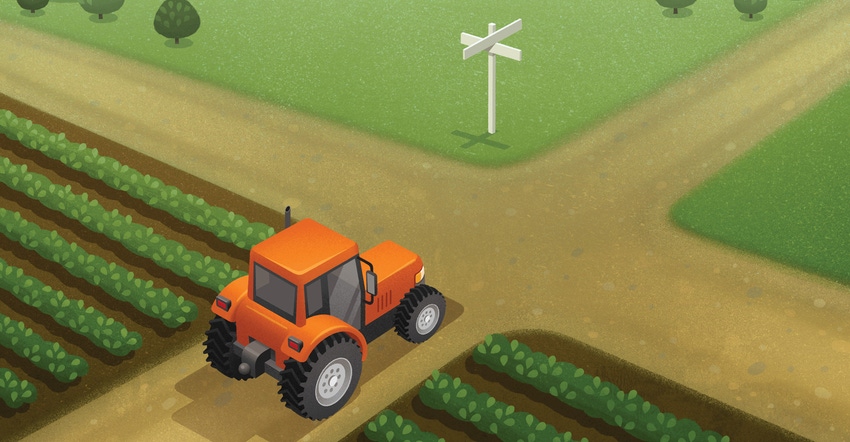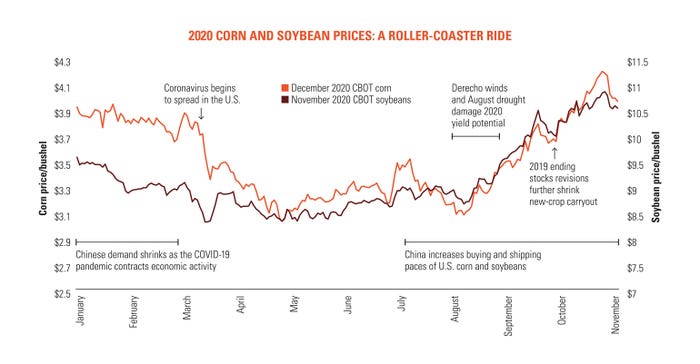
Everyone trashes 2020 as the ‘worst year ever,’ and for the longest time, farmers could justifiably belong to that camp. But a funny thing happened this fall. Combine grain tanks weren’t the only thing getting filled up. Big federal government checks, from PLC to MFP and CFAP payments, started landing in farm bank accounts. Around the same time corn and soybean markets began to soar even as combine monitors revealed trend to record yields. All of it offered farmers a rare chance to make profitable sales off the combine, and even lock in futures contracts at profitable levels for 2021 production.
The result? A farm economy that had limped along for six years is, at least temporarily, clicking on all cylinders. Grain farmers who worried about dwindling working capital and cash that wouldn’t flow find themselves making decisions about a windfall (assuming you made sales). And no one really expected it just four months ago.
“This might be the silver bullet that gets many farmers over the hump this year,” says farm consultant Tim Schaefer with Encore Consultants. “There’s gotta be a lot of bankers breathing a sigh of relief right now.” Adds CliftonLarsonAllen CPA Paul Neiffer: “Farmers were singing the blues back in April. Now they’re asking how to get their tax liability down.”
Still a risky business
To be sure, one good streak does not mean farming just got easier or less risky. Since early last year farmers have worked around waterlogged seeds, flattened crops and mini-droughts; they endured broken supply chains and an ongoing global health crisis. Now, with a new White House and Congress, they face a fresh set of tax rules, environmental and trade policies, and regulatory unknowns. And again, those who rapidly adapt to change will likely remain profitable.
But really - does anyone think the streak of Black Swans is behind us?
“It’s time to make sure you can handle everything that 2021 and beyond could throw at you, from deflation to inflation, to a three-year global recession, to a commodity boom, a weak dollar, to higher taxes -- you name it,” says Farm Futures contributing market analyst Bryce Knorr. “It’s time to ask yourself: are you a good enough manager for a real-time world?”
Go out on top?
Feeling more confident about the future feels rewarding, but it impacts every grower differently. For the young it’s a chance to sock away working capital. For the middle-aged it might mean upgrading equipment or re-evaluating a growth opportunity.
And for senior operators, this just might be the right time to make room for another generation.
“If you think you’re probably going to transition out in the next three years, get it started right now while prices are high,” Schaefer recommends. “Then you can see it as an opportunity to go out on top."

Managing year-end decisions
But let’s say you’re in the ‘regroup’ category. Your short-term goal is to manage income tax and make good decisions as you plan for 2021. What should you do before the clock strikes midnight Dec. 31?
The quick answer is, call your accountant, quips Neiffer, author of the popular Farm CPA Today blog (blogs.claconnect.com/agribusiness/). Some talking points?
Evaluate cash flow needs. Several grain producers were able to sell beans out of the field for profitable prices. They also have government relief payments from CFAP or traditional farm bill programs. If you don’t need the cash now you have options on how much income you can take in 2020. “For a lot of those producers, they don’t necessarily want additional income right now,” he says.
Consider a deferred payment contract. These allows you to sell grain now but get paid in 2021. “The nice feature is that they are considered an installment sales contract,” says Neiffer. “We can elect to bring that income into 2020 if we’re shooting too low. I like to utilize that even more than prepayment on farm crop inputs. It doesn’t mean they get delivered – you just pay for what you need, lock in price and quantity, and we can deduct the cost even if you don’t take delivery. You have to pay cash in December.” Farmers who use accrual accounting can’t use deferred payment contracts.
Consider how the election might change your tax strategy. “If we have a new president or congress in 2021 and you’re trying to defer taxes to 2021, you might want to think about the tax structure you may be deferring too,” he says. “That is why I like to use deferred payment contracts. Normally the income would be reported in 2021 but we can push it into 2020 if we want to.”
Consider your debt situation when you make tax decisions. Maybe it’s time to pay down some debt before making a big purchase. “Any tax-related decision you make today does have a long term impact on cash flow,” says Chris Olson, general manager at Rabo AgriFinance in Cedar Falls, Iowa. “You don’t want to increase overall debt service just to manage tax liability. Talk to your lender about a new acquisition, or about how it would impact cash flow over the next five years.”
Calculate 2021 crop break evens and stick to your marketing plan. If you haven’t yet, revise your crop budgets. With higher grain prices some crop budgets pencil out just fine even without ad hoc government payments in 2021 -- as long as you avoid high cash rent or land costs. “Knowing break evens gives you the confidence to lock in futures contracts for profits in ‘21 or even ’22,” notes Neiffer. “If your corn breakeven is $3.85 and you can lock in a percent of future production at $4.25 maybe you should make some sales.” Margin management has been key to every producer the past six years, adds Olson. “We’ve seen it more in spring during rallies but sometimes we’re unsure about break evens and margins, because we’re thinking about making sales in spring during rallies. Right now, you don’t have that concern. So, evaluate your overall costs and make some sales.” Adds Neiffer: “Don’t be ‘that guy’ who waits for price to go to $5, and then often falls to $3. You’re not in the speculation business. Lock in your profit and move on.”
Replenish working capital. Working capital is the first defense against commodity price volatility. For row crop farmers a benchmark is having working capital that, at a minimum, equals next year’s crop expenses. So if next year’s crop expenses come to $2 million, that’s how much you should have available now in cash, receivables and grain on hand. “Some farmers have four or five times that much, but to me, you should have a minimum of 1 to 1 because then you can make informed decisions,” says Neiffer. “If you’re lower than that the bank and the market is telling you what to do, not the other way around.” Olson believes it may be time to rebolster working capital with some profit and hang on to that dry powder. “Because frankly, what’s the next tidal wave we’re not prepared for?” he asks rhetorically. “It’s a balance between keeping cash on hand, managing tax liability, and the long term impact of any capital purchases. We don’t want to make cash flow more challenging, as it has been in the past.”
Consider capital expenditures with a critical eye. Sure, a shiny new combine would look good in the shed, but do you need it? Farmers find all kinds of ways to justify big ticket purchases when tax deferment is the goal. Just don’t trade equipment until you are sure it makes sense for your operation. Evaluate current horsepower and machinery costs per acre, potential expansion, labor needs, and the need for technology upgrades. From a tax perspective an equipment trade is more or less a zero sum game, says Neiffer. Let’s say your old combine is valued at $200,000 and you trade for a $500,000 machine; you report a gain of $200,000 but you deduct the full $500,000 on the new combine. The extra $300,000 is a deduction on federal taxes. “I know a 3,000-acre Missouri farmer who has a 10-year-old and 14-year-old combine and he’s making money,” says Neiffer. “He’s got plenty of net worth, but he says what he has works just fine. I also know another farmer who trades a new Gleaner every year because he doesn’t want to deal with repairs, and the trade-in value has been good for him. There is no right answer, but the farmer needs to know what’s best for him or her.”
CARES allows some deductions. If you itemize your income tax deductions, the Coronavirus Aid, Relief and Economic Security Act is suspending the limitation on certain charitable contributions and is allowing deductions up to 100% of adjusted gross income. Excess contributions can be carried over as deductions for the next five years. The CARES Act also provides that people can withdraw up to $100,000 from their retirement accounts without this being subject to the normal 10% penalty if they are under age 59 1/2. The act waives the 2020 required minimum distributions from retirement accounts, too. Check with your tax professional to see if these are good options for you.
About the Author(s)
You May Also Like






